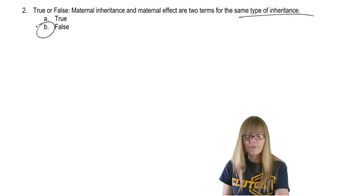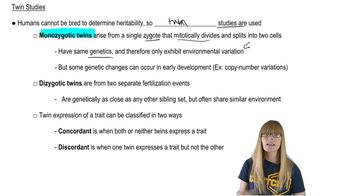Cattle breeders would like to improve the protein content and butterfat content of milk produced by a herd of cows. Narrow sense heritability values are 0.60 for protein content and 0.80 for butterfat content. The average percentages of these traits in the herd and the percentages of the traits in cows selected for breeding are as follows. Trait Herd Average Selected Cows Protein content 20.2% 22.7% Butterfat content 6.5% 7.4% Determine the selection differential (S) for each trait in this herd.
Table of contents
- 1. Introduction to Genetics51m
- 2. Mendel's Laws of Inheritance3h 37m
- 3. Extensions to Mendelian Inheritance2h 41m
- 4. Genetic Mapping and Linkage2h 28m
- 5. Genetics of Bacteria and Viruses1h 21m
- 6. Chromosomal Variation1h 48m
- 7. DNA and Chromosome Structure56m
- 8. DNA Replication1h 10m
- 9. Mitosis and Meiosis1h 34m
- 10. Transcription1h 0m
- 11. Translation58m
- 12. Gene Regulation in Prokaryotes1h 19m
- 13. Gene Regulation in Eukaryotes44m
- 14. Genetic Control of Development44m
- 15. Genomes and Genomics1h 50m
- 16. Transposable Elements47m
- 17. Mutation, Repair, and Recombination1h 6m
- 18. Molecular Genetic Tools19m
- 19. Cancer Genetics29m
- 20. Quantitative Genetics1h 26m
- 21. Population Genetics50m
- 22. Evolutionary Genetics29m
20. Quantitative Genetics
Heritability
Problem 26b
Textbook Question
The children of couples in which one partner has blood type O (genotype ii) and the other partner has blood type AB (genotype IᴬIᴮ) are studied. What is the expected concordance rate for blood type of DZ twins in this study? Explain why this answer is different from the answer to part (a).
 Verified step by step guidance
Verified step by step guidance1
Step 1: Begin by understanding the genetic inheritance of blood types. Blood type is determined by the ABO gene, which has three alleles: Iᴬ, Iᴮ, and i. The Iᴬ and Iᴮ alleles are codominant, meaning both are expressed when present together, while the i allele is recessive.
Step 2: Analyze the parental genotypes. One parent has blood type O (genotype ii), meaning they can only pass on the i allele. The other parent has blood type AB (genotype IᴬIᴮ), meaning they can pass on either the Iᴬ or Iᴮ allele.
Step 3: Determine the possible genotypes of the offspring. Using a Punnett square, combine the alleles from each parent. The offspring can inherit either Iᴬi or Iᴮi, resulting in blood types A or B, respectively. There is no possibility of blood type AB or O in this case.
Step 4: Understand the concept of concordance rate in DZ (dizygotic) twins. DZ twins share approximately 50% of their genetic material, as they are formed from two separate fertilized eggs. The concordance rate for blood type depends on whether both twins inherit the same genotype (Iᴬi or Iᴮi) or different genotypes.
Step 5: Compare this result to part (a). The concordance rate for DZ twins is lower than for monozygotic (MZ) twins because MZ twins are genetically identical, while DZ twins are not. This difference arises due to the independent assortment of alleles during gamete formation and fertilization.
 Verified video answer for a similar problem:
Verified video answer for a similar problem:This video solution was recommended by our tutors as helpful for the problem above
Video duration:
1mPlay a video:
Was this helpful?
Key Concepts
Here are the essential concepts you must grasp in order to answer the question correctly.
Blood Type Inheritance
Blood type is determined by the ABO gene, which has three alleles: A (Iᴬ), B (Iᴮ), and O (i). Individuals with blood type O have the genotype ii, while those with blood type AB have the genotype IᴬIᴮ. The offspring of these parents can inherit one allele from each parent, leading to potential blood types A (Iᴬi) or B (Iᴮi), but not AB or O.
Recommended video:
Guided course

Types of Maternal Inheritance
Dizygotic (DZ) Twins
Dizygotic twins, or fraternal twins, arise from two separate eggs fertilized by two different sperm cells. They share about 50% of their genetic material, similar to regular siblings. The genetic diversity in DZ twins can lead to different blood types among them, depending on the alleles inherited from their parents.
Recommended video:
Guided course

Twin Studies
Concordance Rate
Concordance rate refers to the likelihood that both twins in a pair exhibit the same trait or characteristic, such as blood type. In the case of DZ twins from the given parental genotypes, the expected concordance rate for blood type would be lower than that of monozygotic twins, as DZ twins share only half of their genetic information, leading to a greater chance of differing blood types.
Recommended video:
Guided course

New Alleles and Migration

 7:04m
7:04mWatch next
Master Calculating Heritability with a bite sized video explanation from Kylia
Start learningRelated Videos
Related Practice
Textbook Question
437
views
